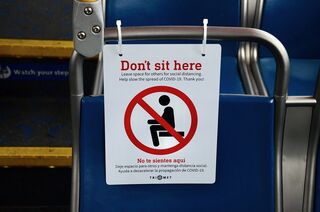Coronavirus Disease 2019
Corona's Behavioral Marathon
What science tells us about why people follow COVID-19 measures.
Posted September 24, 2021 Reviewed by Ekua Hagan
Key points
- Behavioral rules remain necessary in order for the world's population to fight against COVID-19.
- As vaccinated people become less afraid of COVID-19 and politicians polarize the public, compliance with mitigation measures has decreased.
- To ensure future compliance with COVID-19 measures, intrinsic motivation and practical capacity are key.
Once again, about 120,000 Americans each day are getting infected with COVID. The daily average hospitalization rate is over 90,000—larger than the entire population of Santa Monica, California, or Boca Raton, Florida. And worse, 2,036 Americans are dying each day due to COVID—nearly as many as during the height of the first wave in the spring of 2020.
The problem is not just that America’s vaccination rate has stagnated. While the vaccines are remarkably effective, the Delta variant is still dangerous for fully vaccinated people. Currently, one in four people hospitalized in the US due to the coronavirus was already fully vaccinated.
Why vaccines are not enough
We are all tired of the pandemic and ready to get back to 2019, yet Israel paints a grim picture of what America’s near-future looks like. Due to incredible early vaccination rates, by June of 2021, Israeli citizens could work, party, compete, shop, celebrate, dance, and eat in groups and crowds without a mask, without testing, and without social distancing. It was a shining beacon of hope. Yet, the Delta variant ruined everything.
A little over a month later, Israel has become one of the five most highly infected countries in the world. In response, Israeli authorities have brought back many of the original virus mitigation measures. And if these fail, the government is even considering a new lockdown, where people will not be allowed to wander more than 100 meters from their homes.
We are facing a grim reality check. America, just like Israel and all the other countries with successful vaccine programs, will continue to endure waves of the virus and its variants.
The current pandemic has become a behavioral marathon, asking people to fundamentally change their lives not for weeks or months, but for years. And the longer we run this race, the harder it gets.
The vaccine will need to rely on help from behavioral measures that effectively get people to protect themselves and others. It will have to co-exist with bouts of mask mandates, social distancing, handwashing, self-testing, forced quarantine, travel restrictions, and at worst lockdowns. But how do we enhance compliance with the COVID-19 mitigation measures and keep ourselves safe?
What science can tell us
Fortunately, researchers have been building a behavioral arsenal, a rich knowledge base on what promotes compliance. Since the pandemic began, we have been conducting research in the US, Israel, the Netherlands, China, and the UK to understand why people comply with lockdown and social distancing rules. Based on our cross-national, cross-sectional, and longitudinal studies, we know what works.

First, many governments have tried to threaten people into compliance with punishments or fines. Yet despite this intuitive approach, we found that it rarely worked. In fact, punishment threats were overall quite ineffective. To ensure compliance, we must look beyond the stick.
Compliance was much more about intrinsic motivation and social context. People who feared the disease and who supported the mitigation policies were more likely to comply, as were people who thought that other people supported complying. However, after the first wave, these intrinsic motivations eroded rapidly. Many people have become less afraid of the virus, especially after getting vaccinated. In addition, compliance became political. Politicians actively polarized the mitigation measures and undermined public support for the policies. Wearing a mask incorrectly, if at all, became a political statement. And over time, more people started to violate the rules, and this normalized rule violation and undermined compliance across the political spectrum.
So if the stick does not work, and the power of intrinsic motivation has dwindled, what can we do? Our studies find that there is another powerful force at play, one that has by far the strongest influence across all contexts and waves we have studied. We call it the “practical capacity.”
The practical capacity refers to the fact that people who can follow the mandates are much more likely to comply. Rather than focus on punishing or fining violators, practical capacity means we must prioritize making sure people are actually able to follow the rules. That starts with making the rules clear, uniform, and understandable (and don’t keep changing them). Then, we must make compliance itself as easy and as cheap as possible. Ensure that people can work from home and avoid crowded places, support businesses in installing proper ventilation systems and social distancing-promoting barriers, and support research to make mask-wearing more comfortable.
Moving beyond intuition
Until the virus has truly petered out, or once we have enough vaccinated people to achieve long-term herd immunity, we will have to keep up the behavioral marathon. Rather than rely on what we intuitively feel might work, we must turn to the rich available data and develop science-based policies. Only then can we safely run this unwelcome race.




